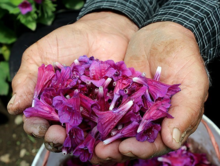Echium amoenum
This article needs additional citations for verification. (October 2020) |
| Echium amoenum | |
|---|---|

| |
| Scientific classification | |
| Kingdom: | Plantae |
| Clade: | Tracheophytes |
| Clade: | Angiosperms |
| Clade: | Eudicots |
| Clade: | Asterids |
| Order: | Boraginales |
| Family: | Boraginaceae |
| Genus: | Echium |
| Species: | E. amoenum
|
| Binomial name | |
| Echium amoenum | |
| Synonyms | |
|
Echium orientale C.A.Mey. (1831) | |
Echium amoenum (In Persian: گل گاوزبان) or Iranian Borage is one of the important medicinal herbs in Iranian traditional medicine.[1] It is a biennial or perennial herb indigenous to the narrow zone of northern part of Iran, Caucasus, and southern Russia, where it grows at elevations ranging from 60 to 2,200 m (200 to 7,220 ft). E. amoenum has been advocated for a variety of effects such as demulcent, anti-inflammatory and analgesic, especially for the common cold, and as an anxiolytic and sedative.[2][3]
Description
[edit]
The herbaceous plant grows as a two- to perennial herb and reaches heights of around 50 cm. The flowers are about 3 cm long. It owes its Persian name گل گاوزبان (golgāvzabān, roughly “cow's tongue flower”) to its bristly, hairy stems and leaves, is an important medicinal plant in traditional Iranian medicine. The dried flowers are prepared as a tea, which is said to provide relief from some ailments.[4][5]
Effect
[edit]
The flower tea is claimed to have an anti-inflammatory and relaxing effect and is traditionally used, for example, for colds.[6] In particular, the , analgesic, sedating and anti-anxiety.[7]The mechanism of action has not yet been elucidated, but naloxone reduces the analgesic effect, which could indicate the involvement of opioid receptors. Other studies speculate about flavonoids as agents that may bind to benzodiazepine receptors.[8]
See also
[edit]References
[edit]- ^ Motahhari, Khadijeh; Pirani, Atefeh; Moazzeni, Hamid; Joharchi, Mohammad Reza; Bussmann, Rainer W. (December 2022). "High–Demand Medicinal Plants of Herbal Markets in Mashhad, Iran". Economic Botany. 76 (4): 414–433. doi:10.1007/s12231-022-09557-4.
- ^ Abed, A.; Vaseghi, G.; Jafari, E.; Fattahian, Ehsan; Babhadiashar, Nima; Abed, M. (2014). "Echium Amoenum Fisch. Et Mey: A Review on its Pharmacological and Medicinal Properties". Asian Journal of Medical and Pharmaceutical Researches. 4 (1): 21–23. ISSN 2322-4789. S2CID 87427219.
- ^ Hooper, David; Field, Henry (1937). Useful plants and drugs of Iran and Iraq / by David Hooper. With notes by Henry Field. Publication. Field Museum of Natural History. Chicago: [s.n.]
- ^ Malekpour, Monireh; Etebari, Atefe; Hezarosi, Mahsa; Anissian, Ali; Karimi, Forouzan (2022-09-30). "Mouse Model of Irritant Contact Dermatitis". Iranian Journal of Pharmaceutical Research. 21 (1). doi:10.5812/ijpr-130881. ISSN 1735-0328. PMC 9872550.
- ^ Heidari, Mahmoud Reza; Azad, Elham Moein; Mehrabani, Mitra (2006-02-20). "Evaluation of the analgesic effect of Echium amoenum Fisch & C.A. Mey. extract in mice: Possible mechanism involved". Journal of Ethnopharmacology. 103 (3): 345–349. doi:10.1016/j.jep.2005.08.027. ISSN 0378-8741.
- ^ Rabbani, M; Sajjadi, S. E; Vaseghi, G; Jafarian, A (2004-07-01). "Anxiolytic effects of Echium amoenum on the elevated plus-maze model of anxiety in mice". Fitoterapia. 75 (5): 457–464. doi:10.1016/j.fitote.2004.04.004. ISSN 0367-326X.
- ^ Camfield, David; McIntyre, Erica; Sarris, Jerome, eds. (2017). Evidence-Based Herbal and Nutritional Treatments for Anxiety in Psychiatric Disorders (1st ed. 2017 ed.). Cham: Springer International Publishing : Imprint: Springer. ISBN 978-3-319-42307-4.
